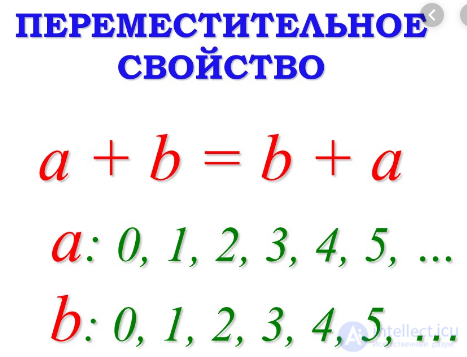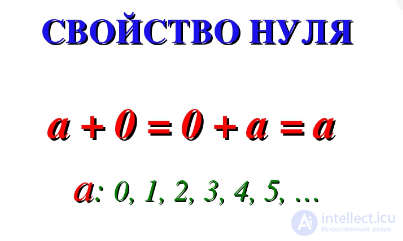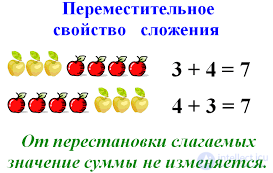Lecture
The properties (or laws) of arithmetic actions on numerical examples we considered in the topic “Laws of arithmetic” for elementary school.
In grade 5, the laws of arithmetic are written using letter expressions. Therefore, we now consider these and other properties in the form of letter expressions.
From the permutation of the terms the amount does not change.
In literal form, the property is written as:
a + b = b + a
In this equality, the letters a and b can take any natural values and the value 0.

To add the third number to the sum of two numbers, add the sum of the second and third numbers to the first number.
In letter form:
(a + b) + c = a + (b + c)
Since the result of the addition of three numbers does not depend on how the brackets are set, you can not put brackets and just write a + b + c.
(a + b) + c = a + (b + c) = a + b + c
The transfer and combination property of addition allows us to formulate a rule for the transformation of sums.
When you add several numbers, you can arbitrarily group them and rearrange them.
The sum of two natural numbers is always greater than each of the terms. But this is not the case if at least one of the addends is zero.

If you add zero to the number, you get the number itself.
a + 0 = 0 + a = a

To subtract a sum from a number, you can subtract one term from it and then subtract another term from the result.
a - (b + c) = (a - b) - c
or
a - (b + c) = (a - c) - b
The brackets in the expression (a - b) - c have no meaning and can be omitted.
(a - b) - c = a - b - c
To subtract a number from the sum, you can subtract it from one term, and add the remaining term to the result.
(a + b) - c = (a - c) + b (if a> c or a = c)
or
(a + b) - c = (b - c) + a (if b> c or b = c)
If you subtract zero from a number, you get the number itself.
a - 0 = a
If we subtract the number from the number itself, then we get zero.
a - a = 0
Comments
To leave a comment
Arithmetic
Terms: Arithmetic